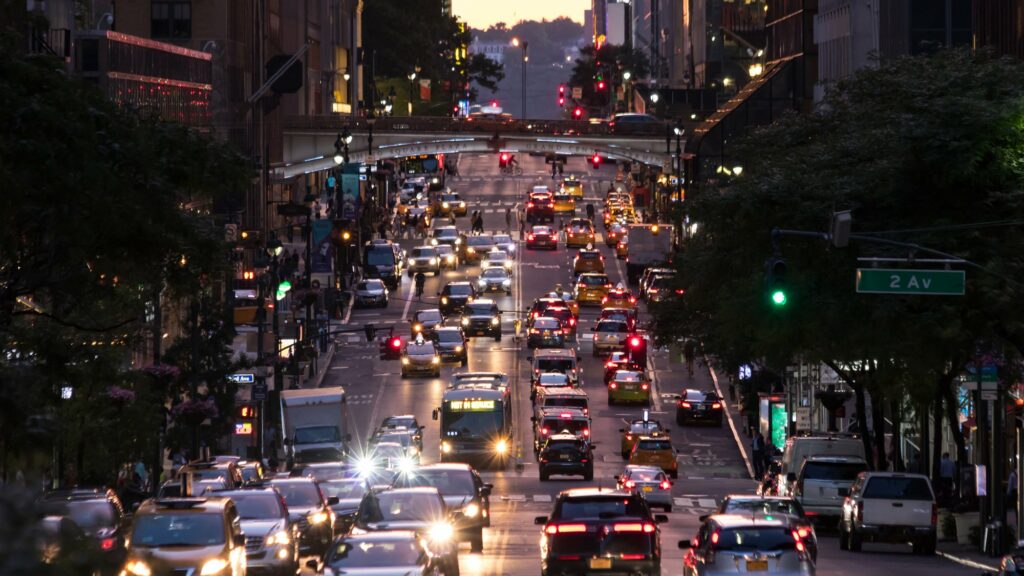The United States’ most populous city could soon have scores of autonomous vehicles (AVs) jockeying their way through bustling streets but they will have to do so with a human sitting behind the wheel. After years of relatively subdued AV testing, New York City this week announced new safety requirements and permitting guidelines for companies looking to test their self-driving cars on public roads. NYC’s new guidelines signal a push toward more AV testing and, eventually, deployment while simultaneously putting in place various guardrails to try and avoid replicating recent missteps in other cities.
How will AV testing work in the Big Apple?
AV companies approved for testing in New York will need to have a safety driver behind the wheel ready to take over at all times. This approach notably differs from cities like Phoenix, which have already let Alphabet-owned Waymo to test “rider only” trips on city streets. The NYC permit documentation does not mention any specific autonomous vehicle makers by name, but says only companies with past testing in other cities would be considered. Safety drivers will be required to have a driver’s license, complete background checks, prove they have adequate training in the vehicles they are testing, and take frequent breaks to avoid distraction or fatigue.
Companies looking to test in the city will have to comply with all local traffic laws and pay any traffic or parking tickets the vehicle may incur. Permits will last for one year with the option for renewal at the end of the test period. Any company applying for a permit will also need to provide proof of at least $5 million in car insurance for any autonomous vehicles testing on NYC highways, as well as a $3 million in personal liability insurance. New York’s Department of Transportation, in a statement, says it will work with AV applicants to ensure testing “does not unduly impede traffic flow, pedestrian and cyclist movement, transit service, or emergency response.”
“We are doing our due diligence to get ahead of the AV revolution, and ensure that if AVs are coming, they do so within a framework that benefits New Yorkers, and creates training and good, upwardly mobile jobs in the autonomous industry,” NYC Deputy Mayor for Operation Meera Joshi said in a statement. “It’s been the story for too long that government can’t keep up with private enterprise. No longer.”
NYC Mayor Eric Adams, who made adoption of AI technology a priority during his administration, echoed that sense of inevitability.
“This technology is coming whether we like it or not, so we’re going to make sure that we get it right,” Adams said in a statement. “If we do, our streets can be safer, and our air could be cleaner.”
The new permitting process marks a pivot point for NYC. Up until now, AV testing hadn’t gained traction to the same degree as other large US cities like San Francisco and Phoenix. General Motors backed Cruise planned to test its vehicles in the city’s back in 2017 but eventually backtracked. Waymo, on the other hand, begun some testing in the city but has reportedly focused primarily on areas of upstate New York.
Driverless vehicles will still have to overcome numerous roadblock for adoption in NYC
Companies looking to commercialize AVs in NYC still face an uphill battle even with the city’s renewed interest in testing. New York’s mix of pedestrian-filled streets, unpredictable vehicle traffic, and sensor disrupting bright lights make it one of the most challenging environments for AVs to navigate successfully. Driverless vehicles have made notable improvements on highways but their effectiveness degrades as they enter more complex, densely populated urban areas. NYC’s DOT itself called the city the “country’s most challenging urban environment.”
Aside from technical challenges, AVs may also face pushback from labor groups and local drivers. The Teamsters previously spoke out against Waymo’s efforts to expand AV testing in the state, calling the technology a “direct threat to public safety.” Two organizations representing New York taxi-cab drivers previously called for legislation banning driverless cars outright in the city. Two third of drivers, recently surveyed by AAA Western and Central New York, meanwhile, said they were afraid of driverless vehicles.
“There has been an increase in consumer fear over the past few years,” AAA Director of Automotive Engineering Research Greg Brannon said in a statement. “Given the numerous and well-publicized incidents involving current vehicle technologies–it’s not surprising that people are apprehensive about their safety.”
Still, supporters of the push for more autonomous vehicles like mayor Adams believe the technology could one day improve safety by cutting back on human error-induced accidents. Supporters hope large scale autonomous vehicle rollout, when paired with improved mass transit, could also potentially cut down on traffic. Electric powered AV robotaxis could also theoretically lead to less emissions than internal combustion alternatives, especially if they are used to transport more than one person at a time.
New York’s new AV approach comes amidst a thawing interest in driverless vehicles nationally. Multiple crashes and missteps by Cruise in California last year resulted in the company losing its ability to operate in the state. Local officials in Austin, once an early adopter in AV’s testing, are now questioning the safety of driverless cars. High profile accidents involving AVs are appearing to impact public perceptions of the vehicles. A study of US drivers conducted in 2023 by J.D. Power found driver trust in self-driving vehicles declined for the second year in a row.
>>> Read full article>>>
Copyright for syndicated content belongs to the linked Source : Popular Science – https://www.popsci.com/technology/nyc-robotaxis-driverless/
